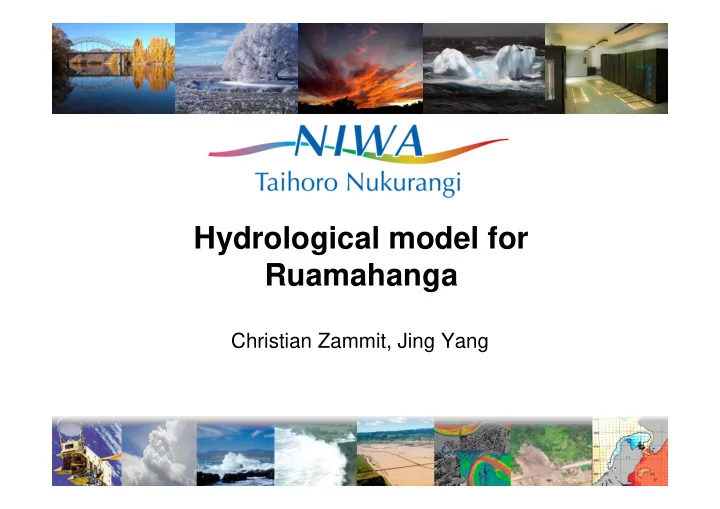

Hydrological model for Ruamahanga Christian Zammit, Jing Yang
Surface Hydrological model 1. Aim of the model 2. Surface water model TopNet 3. Input data 4. Calibration/Validation 5. Regionalisation 6. Limitations
Surface Hydrological model 1. Aim of the model 2. Surface water model TopNet 3. Input data 4. Calibration/Validation 5. Regionalisation 6. Limitations
Aim of surface water model • To provide surface water inflows to the river system discharging to the Ruamahanga groundwater zone 297 discharge entry points Daily time serie 1972-2014 Assumptions: • Upstream catchment processes driven by surface water and snow • Total flow little influenced by groundwater discharge • Two steps process: – Calibration to existing gauging station – Parameter regionalisation to all catchments 4
Surface Hydrological model 1. Aim of the model 2. Surface water model TopNet 3. Input data 4. Calibration/Validation 5. Regionalisation 6. Limitations
TopNet: Semi-distributed Hydrological Model 1. Define stream network and subcatchments 2. Water balance is simulated within each subcatchment (including snow, evapo- transpiration, surface and subsurface flows) 3. Flows from each subcatchment are routed through the river network
TopNet: Semi-distributed Hydrological Model Data Needs • Time series of climate data Landcover Geology (Rainfall, temperature, climate) • GIS data (landcover, geology, soils, topography) • Data is available nationally, can be updated using Regional Councils datasets (eg climate) etc.. Grey Catchment Outputs Modelled Flow • Integrated: Hourly river flow at Measured Flow every river reach • “Catchment Production” : hourly time series of many hydrological variables (e.g. soil moisture) • Naturalised discharge
Surface Hydrological model 1. Aim of the model 2. Surface water model TopNet 3. Input Data 4. Calibration/Validation 5. Regionalisation 6. Limitations
Input Data • Spatial – 30 m national DEM – Soil related information FSL, Land use LCDB v2
Input Data • Climate – VCSN (based on CLIdB) daily grid climate information : 1972-2015 – Does not use GWRC precipitation network
Ruamahanga Input data • Climate Tauherenikau
Surface Hydrological model 1. Aim of the model 2. Surface water model TopNet 3. Input Data 4. Calibration/Validation 5. Regionalisation 6. Limitations
Calibration-Validation • 9 locations Strahler 1 (catch area ~0.5 km 2 ) • • Calibration 2001-2003 • Validation 2003-2010 Site Tideda ID Area (km 2 ) 114.21 Tauherenikau 29251 177.89 Waiohine 29224 Waingawa 29246 76.50 Waipoua 29257 79.84 Ruamahanga 29254 78.70 29230 100.63 Kopuaranga 29244 36.80 Whangaehu Taueru 29231 391.19 Huangarua 29222 139.23 • Calibration for water resource ie reproduction of low flow conditions • Non completed analysis
Calibration-Validation The accuracy of the calibration/validation process is estimated using the following hydrological criteria and statistics: • NS efficiency calculated on discharge (NS- high flow) and logarithm of the discharge (NS Log- low flow- Jan to March). • Total water balance of the upstream catchment • Daily flow duration curve (FDC) (distribution of the flows) and cumulative flow (systematic bias) • Average monthly flows (seasonality of the water balance) • 7 days Mean Annual Low Flow (7days MALF) (low flow conditions) • Monthly flow deciles (potential skewness towards specific flow conditions).
Calibration-Validation- West Waiohine catchment Efficiencies Calibration Validation (2001-2003) (2004-2012) NSlog NS NSlog NS Location Waiohine at Gorge 0. 554 0.372 0.784 0.501 Water Balance TopNet GWRC (2004-2012) (2004-2012) Annual Average Flux (mm/yr) (mm/yr) Mean annual 4297 NA precipitation Mean annual 249 NA evaporation Mean annual runoff 4009 4158
Calibration-Validation- West Waiohine catchment Annual Average hydrological TopNet (2004-2012) GWRC (2004-2012) GWRC (1954-2015) (m 3 /s) (m 3 /s) characteristics (m3/s) Mean Annual Flow 21.592 23.439 24.510 7 days Mean Annual Low Flow 6.000 3.603 7.601 • Hydrological processes and characteristics simulated • Lower than expected evaporation • Low flows overpredicted- Underestimation of peaks • Underprediction discharge during winter months
Calibration-Validation- East Whangaehu catchment Efficiencies Calibration Validation (2001-2003) (2004-2012) NSlog NS NSlog NS Location Whageheu at Waihi 0.726 0.678 0.722 0.755 Water Balance TopNet GWRC (2004-2012) (2004-2012) Annual Average Flux (mm/yr) (mm/yr) Mean annual 1410 NA precipitation Mean annual 734 NA evaporation Mean annual runoff 636 509
Calibration-Validation- West Whangaheu catchment Annual Average hydrological TopNet (2004-2012) GWRC (2004-2012) GWRC (1954-2015) (m 3 /s) (m 3 /s) characteristics (m3/s) Mean Annual Flow 0.571 0.617 0.526 7 days Mean Annual Low Flow 0.031 0.028 0.024 • Hydrological processes and characteristics simulated • Low flows correctly reproduced • Underestimation of spring flows
Calibration-Validation Parameter Sensitivity • Morris method- to main objective function (NSLog) – sensitivity across entire parameter space – Non linearity between parameters • Carried out for each catchments outlet Result • Extreme sensitivity to precipitation correction (gucatch) • 3 groups: – topmodf is the most sensitive parameter in the model (responsiveness of shallow subsurface flow) – swater2 (active soil depth) and dthetat (soil moisture) – hydraulic conductivity at saturation (hydrocon0) (surface water/groundwater interaction processes) and swater1 (plant available water).
Surface Hydrological model 1. Aim of the model 2. Surface water model TopNet 3. Input data 4. Calibration/Validation 5. Regionalisation 6. Limitations
Regionalisation • Based on – Soil drainage similarity based on FSL – Soil type – Climate range input
Surface Hydrological model 1. Aim of the model 2. Surface water model TopNet 3. Calibration/Validation 4. Input data 5. Regionalisation 6. Limitations
Spatial correction of climate inputs • Reduce station network to drive VCSN interpolation – Potential increase uncertainties in Precipitation and Temperature
Groundwater inflows to GW zone • Kopuaranga Spring
Summary 1. Surface water model built and calibrated 9 upstream locations 2. Model provides inflows at 297 locations to GW Zone 3. Calibration/ Validation acceptable to good 4. Limitations due to climate inputs observations and potential non negligible GW inflows
Next step • Complete analysis • Completed uncertainty analysis • Climate change impact on total water flows
Recommend
More recommend